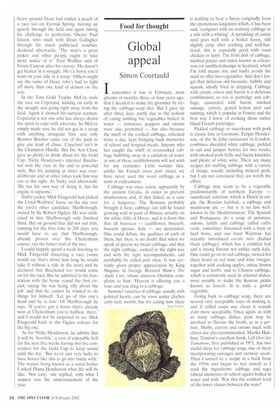Global appeal
Simon Court auld
Iremember it was in February, most gloomy of months, three or four years ago, that I decided to make life gloomier by trying the cabbage-soup diet. But I gave up after three days, partly due to the tedium of eating nothing but vegetables boiled in water — tomatoes, peppers and onions were also permitted — but also because the smell of the cooked cabbage, reheated twice a day, kept bringing back memories of school and hospital meals. Anyone who has caught the whiff of overcooked cabbage bubbling away in a cauldron of water at one of these establishments will not wish for any reminder. Little wonder that, unlike the French (mon petit thou), we have never used the word cabbage as a term of endearment.
Cabbage was once eaten, apparently by the ancient Greeks, in order to prevent drunkenness and, if that failed, as a cure for a hangover, The Romans probably brought it here: cabbage can still be found growing wild in parts of Britain, notably on the white cliffs of Dover, and it is from this that all brassicas — cauliflower, broccoli, brussels sprouts. kale — are descended. One could debate the qualities of each of them, but there is no doubt that when we speak of greens we mean cabbage, and that the right cabbage, cooked in the right way and with the right accompaniments, can justifiably be called petit chou. It was certainly given proper appreciation by King Magnus, in George Bernard Shaw's The Apple Cart, whose mistress Orinthia complains to him: 'Heaven is offering you a rose; and you cling to a cabbage.'
Summer varieties of cabbage, usually with pointed hearts, can be sown under cloches early next month, but for eating now there is nothing to beat a Savoy (originally from the eponymous kingdom) which, it has been said. 'compares with an ordinary cabbage as a sole with a whiting'. A sprinkling of cumin seed goes well with a boiled Savoy, still slightly crisp after cooking and well-buttered; this is especially good with roast chicken or lamb. The Irish dish of cabbage, mashed potato and onion known as colcannon (or rumbledethumps in Scotland, which I'm told means mix and bash) avoids the need to offer two vegetables. And don't forget that delicious old favourite, bubble and squeak, ideally fried in dripping. Cabbage with cream, onion and bacon is a delicious combination; so too is partridge and cabbage, casseroled with bacon, smoked sausage, carrots, grated lemon peel and nutmeg, which is popular in France and the best way I know of cooking those rather bland French partridges.
Pickled cabbage or sauerkraut with pork is classic fare in Germany. Fergus Henderson, of the St John restaurant in London, combines shredded white cabbage, pickled in salt and juniper berries for two weeks, with smoked pork belly and bacon knuckles and plenty of white wine. There are many recipes for stuffing cabbage with a variety of things, usually including minced pork, but I am not convinced they are worth the effort.
Cabbage may seem to be a vegetable predominantly of northern Europe — sauerkraut, coleslaw, which is Dutch in origin, the Russian kulebiak, a cabbage and mushroom pie — but it is no less wellknown in the Mediterranean. The Spanish and Portuguese do a soup of potatoes, onions, lentils and cabbage called caldo verde, sometimes flavoured with a ham or beef bone, and our local Waitrose has recently introduced cavolo nero (Italian black cabbage), which has a crinkled leaf and a strong flavour not unlike curly kale. One could go on to red cabbage, stewed for three hours in red wine and wine vinegar, together with cooking apples, onion, brown sugar and herbs; and to Chinese cabbage, which is commonly used in oriental dishes, most notably to make the Korean pickle known as kimchi. It is truly a global vegetable.
Going back to cabbage soup, there are several very acceptable ways of making it, and if called soupe aux choux it sounds even more acceptable. Once again, as with so many cabbage dishes, pork may be involved to flavour the broth, as in a garbure. Herbs, carrots and onions stuck with cloves are also recommended. Marika Hanbury Tenison's excellent book, Left Over for Tomorrow, first published in 1971, has two useful ideas for cabbage soup, one of them incorporating sausages and caraway seeds. Then I turned to a recipe in a book from the 1930s and began to feel unwell as I read the ingredients: cabbage and sago (dread memories of school again) boiled in water and milk. Was this the comfort food of the lower classes between the wars?




































































 Previous page
Previous page